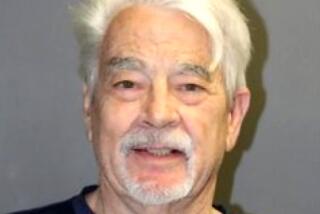Outcome of McMartin Trial May Hinge on Vital Testimony of Physician
- Share via
The lengthy McMartin Pre-School molestation trial has reached a critical stage, the jury having heard three weeks of testimony from the only physician who examined all 13 children who have accused teachers Raymond Buckey and his mother, Peggy McMartin Buckey, of sexual abuse.
The prosecution’s case against the Buckeys--who face 100 counts of molestation and conspiracy--hinges on whether the jury believes the children and Dr. Astrid Heger, a pediatrician who directs County-USC Medical Center’s child sexual abuse program.
Only four alleged victims have taken the stand so far. They described being raped, sodomized and subjected to other sexual abuses by the Buckeys.
Heger’s testimony, based on physical exams she conducted, strongly supported the children’s accounts. Defense lawyers tried to discredit her as inexperienced and biased, and to show that medical diagnosis of past sexual abuse is still an inexact science.
“She is an extremely important witness,” Los Angeles Superior Court Judge William Pounders said recently when defense attorneys tried to delay Heger’s testimony. “It would seem to me you’ve been sharpening your knives (for her) for a long time.”
Indeed, both sides agree that Heger is a key witness.
Viewpoint of Defense
Defense attorney Daniel Davis, arguing unsuccessfully to reopen his cross-examination of Heger last week, complained that the jury had seen an “articulate and engaging witness” who seemed to be saying:
“I looked at their bodies and whatever you think of their testimony or statements beforehand, as a doctor I saw something. And that . . . can replace, in effect, what the children would or would not successfully testify to.”
Heger testified that she found physical evidence of molestation in 10 of 13 alleged victims. She interpreted the scars, tears and enlarged body openings she found in examining the genitalia and anuses of the children as signs of “blunt-force penetrating trauma” consistent with the repeated sodomy and rape they have described.
She said she found nothing that would contradict the children’s assertions. “I came to the conclusion that their findings--their history and their medical findings--were consistent with sexual abuse,” said Heger, known to the children as “Dr. Sparky.”
She examined the children four years ago while a consultant to Children’s Institute International, a diagnostic and treatment center where many who attended McMartin first disclosed that they had been molested.
Heger’s medical exams of the 13 child witnesses were done only after they had told a parent, therapist, or institute interviewer about their alleged abuse. (Those interviews, which were videotaped, have been characterized by both the defense and Dist. Atty. Ira Reiner as leading and suggestive, but they are certain to play an important role later in the trial).
Heger explained that because sexual abuse often leaves no detectable signs she was surprised to find injuries--in some cases injuries indicative of severe trauma--in so many children. She documented physical findings in three boys and seven girls, and noted that five of the girls showed signs of having been penetrated both vaginally and anally.
Considered an Expert
Heger said she found no physical evidence in three of the 13 witnesses. She added that “dozens” of about 150 former McMartin students whom she examined did not appear to have been molested.
“The one thing that came through loud and clear,” prosecutor Roger Gunson said, “is that she has a high level of expertise and that her methods in (the diagnosis of child sexual abuse) are accepted not only locally, but statewide, nationally and worldwide.
“She had the foresight to document her physical findings, findings indicative of significant sexual abuse,” he said in an interview after Heger stepped down from the witness stand. He said that the physician has now examined more than 1,500 children for suspected sexual abuse, and that four years of additional experience “has not undermined but rather substantiated and strengthened her initial opinion.”
Heger preserved her findings with written medical histories and examination reports, and with pictures taken with a colposcope, a camera-like machine that takes magnified, three-dimensional photographs of genital and anal areas. The resulting slides were later reviewed by other physicians and shown to the jury last month.
Bias Alleged
During 11 days of cross-examination, the defense sought to show that the methods used to diagnose past abuse are unproven and that Heger is biased--both because her reputation rests on the McMartin case and because she herself was molested as a child.
“Hopefully, the jury was left with evidence which demonstrates that medical diagnosis of so-called signs of old trauma is unreliable at this stage,” Dean Gits, attorney for Peggy McMartin Buckey, 61, said in an interview at the completion of Heger’s testimony.
“It would be a tragedy if these two defendants were convicted based on medical evidence that may some day prove to be worthless,” he said, referring to the fact that the field of child sexual abuse is a new sub-specialty in medicine.
Heated Exchange
In one heated exchange after Heger had insisted that both normal and abnormal physical findings can be consistent with sexual abuse, Gits asked pointedly, “Is there any medical evidence that is clearly inconsistent with child molestation?”
“That would say this child was not molested?” Heger asked.
“Yes,” said Gits.
“No,” Heger answered.
“In that case, what good is the medical examination?” asked Gits.
“It has tremendous importance . . . to the child,” replied Heger.
“What about to the trier of fact?” asked Gits.
“Well, I am not the trier of fact, Mr. Gits,” Heger said.
The physician frequently turned hostile questions from the defense to her advantage, striding across the courtroom, pointer and microphone in hand, and speaking directly to the jury about the meaning of the graphic slides projected to them.
Much of the cross-examination focused on debate over the conclusions of a recent study by Harvard pediatrician Jean Emans and how they should be interpreted. Both sides claimed that the study supports their respective positions.
Emans compared three groups of girls--one composed of sexually abused youngsters, a second consisting of a normal “control” population and a third composed of girls with genital complaints but no known history of abuse.
The study found clear differences between the genitalia of the sexually abused and normal children, but some overlap in the physiological characteristics of the sexually abused group and those with other genital complaints, such as vaginitis.
Complicating the study, however, was the fact that several children with genital complaints had to be transferred to the sexually abused group after they were discovered to have a sexually transmitted disease, although initially they had not said they were molested.
Venereal disease also was found in several more children in the third group after the study was published, leading Emans to conclude, according to court testimony, that some in the third group should have been in the sexually abused group all along.
“Now isn’t the bottom line of that study, doctor, that none of the findings is specific for only sexual abuse?” Gits asked Heger.
“No, it’s not,” Heger insisted. “The bottom line, I think, of the study . . . (is) that children . . . who we now know were sexually abused . . . did not tell.”
Has Much at Stake
Outside the courtroom, defense attorneys accused Heger of bias.
“I think we’ve established that she owes her recognition as a leader in the field of child sexual abuse to McMartin and that she has a lot at stake,” Gits said in an interview.
During cross-examination, Davis, who represents Raymond Buckey, 29, asked Heger if she had ever been a victim of molestation.
“Yes,” she replied, explaining that as a 3-year-old, a teen-age family friend had stuck his hand up her dress, and that on two subsequent occasions she was “flashed” from a car. She said she did not believe that those instances had affected her objectivity as a physician, noting that an estimated 40% of American women have had similar experiences.
The defense said Heger’s findings frequently contradicted testimony from the children’s parents, information contained on forms they filled out at Children’s Institute International and medical records from the pediatricians who were caring for the youngsters at the time they attended McMartin.
Defense attorneys did not deny the existence of scars or other vaginal and anal characteristics, except to suggest that some might be only photographic reflections. Instead, they took issue with what Heger said they meant.
But Heger stood her ground, insisting that the shapes and patterns of scarring and the precise size and locations of the injuries were such that they would not have been caused by bowel problems, masturbation or the insertion of pencils or toys, but rather by forceful sexual assault.
More to Read
Sign up for Essential California
The most important California stories and recommendations in your inbox every morning.
You may occasionally receive promotional content from the Los Angeles Times.













